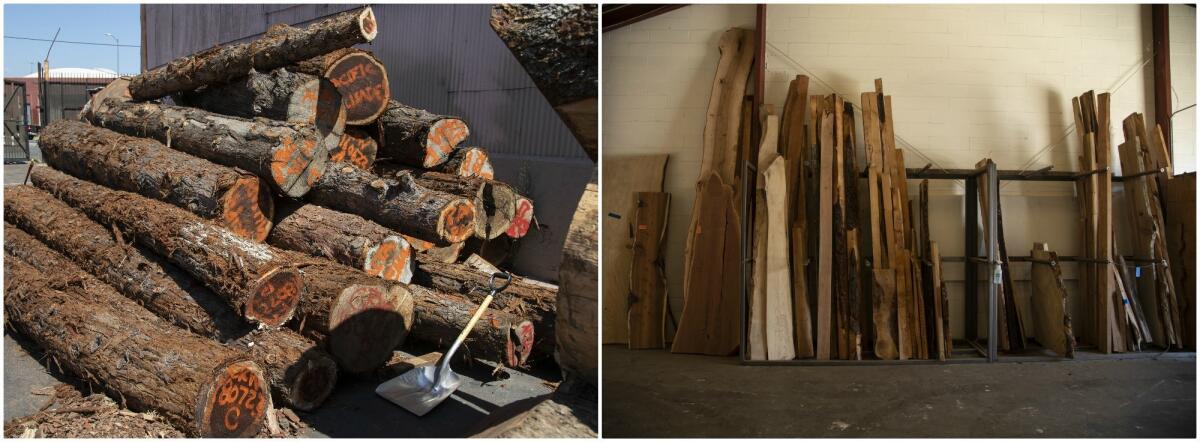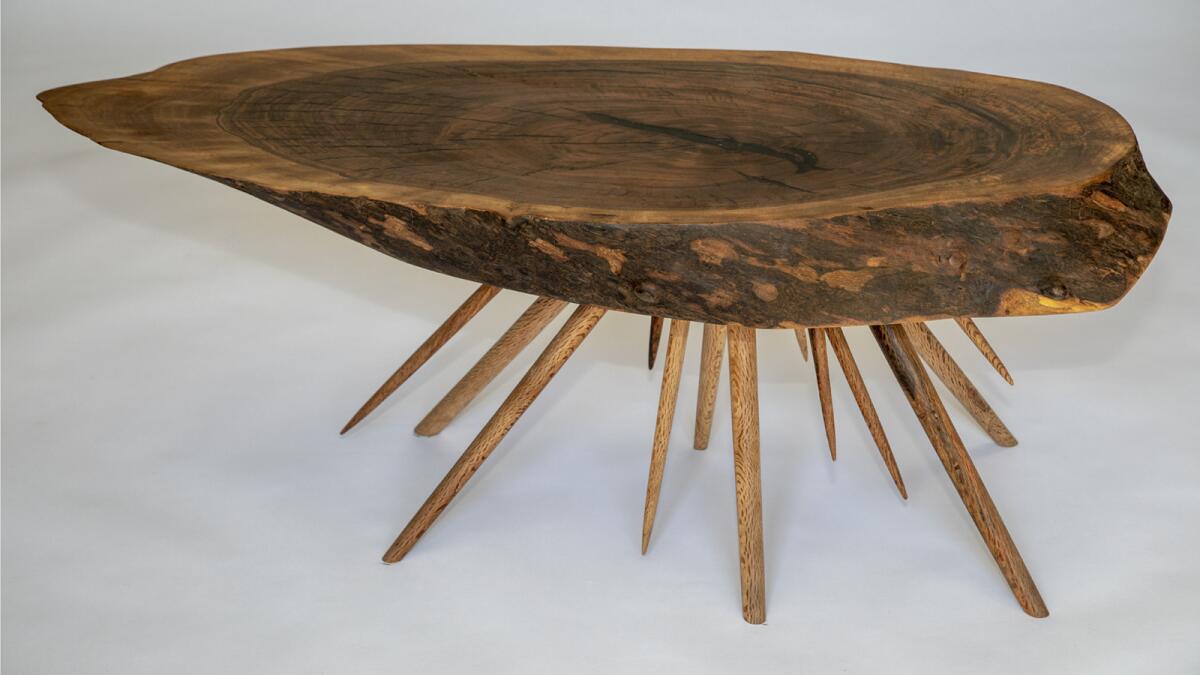Downed L.A. trees are reborn as design items in homes and restaurants

That downed tree in your Los Angeles neighborhood? It has a chance at a second life.
“We have a goal of getting as many trees out of the waste stream as possible,” says Charles DeRosa, who co-founded Angel City Lumber with woodworker Jeff Perry.
For the record:
2:25 p.m. March 26, 2019This story has been updated to include an image designer Stefan Bishop.
After collecting downed trees from around the city, the Boyle Heights company proceeds to the laborious task of milling, drying, surfacing and sanding the wood. Angel City sells the processed wood to local designers, DIYers and, well … anybody who needs wood.
The felled local lumber then becomes beautiful design items. The cost of the lumber to Angel City’s patrons varies depending on its type, size and quality of the wood, DeRosa says.
Perry got the idea for Angel City Lumber after he was unable to collect a fallen 100-year-old live oak tree from an Altadena forest. He found out later that it was chopped to bits the week after. Perry and DeRosa now know that Perry wasn’t able to collect the tree because of liability issues the city would face should anything occur during its retrieval.

I’ve spent countless hours trying to find sustainably sourced wood that performs well outdoors — which is akin to searching for a unicorn.
— Ruth Siegel of Rios Clementi Hale Studios
The complexity of working through the system is the reason Angel City Lumber has yet to establish partnerships with the cities around Los Angeles.
“Once you get involved with the government system, it gets pretty difficult,” DeRosa says.
Despite the setback, Perry realized there was a supply of fallen wood in L.A.’s communities that needed to be saved from landfills. He then partnered with DeRosa, whom he knew through woodworking circles.
After two years spent collecting and processing enough wood, Angel City Lumber officially opened for business in 2017 at a 10,000-square-foot warehouse by the Los Angeles River, a block from Self-Help Graphics. Angel City also keeps a 6,000-square-foot space to store its collected wood.
Angel City Lumber is a “win-win-win” proposition says Ruth Siegel of design firm Rios Clementi Hale Studios. Private-property owners get a fallen tree out of their yard at no cost (they could even request to get part of the wood back as a memento), Angel City adds to its supply of lumber, and L.A.’s makers are able to source local wood with a meaningful history at a price competitive to commercial lumber.

“I’ve spent countless hours trying to find sustainably sourced wood that performs well outdoors — which is akin to searching for a unicorn,” Siegel says. “All options are compromised in one way or another. Most of the better options are being trucked across the country or shipped across an ocean. It’s really exciting to know that this wood is coming from our urban backyard, that we are taking it out of the waste stream and it’s really beautiful.”
Rios Clementi Hale Studios is planning to use about 75 tons of rescued wood on the soon-to-open 1 Hotel in West Hollywood. “It might be the biggest urban lumber project anywhere ever,” DeRosa speculates.
Many other L.A. makers are using Angel City’s local lumber in their projects.
“Green waste is the third-largest component of municipal solid waste,” says Mia Lehrer, principal at Studio-MLA, who used Angel City for Manuela, Hauser & Wirth’s seasonally driven restaurant. Using Angel City lumber is “another great way we can be good stewards of the earth. Their lumber has an age and character that can’t be replicated and is unique to L.A.”

Studio-MLA used cedar from Mar Vista to create swarthy, organic benches and discarded redwood logs from Griffith Park’s wood graveyard to build raised planters. Designer Leslie Shapiro Joyal used a 16-foot piece of California sycamore from Hollywood as a shelving for a Whitley Heights residence.
Angel City Lumber is also in talks with the Eames Foundation to rescue eucalyptus trees from the Eames House in Pacific Palisades, which may find new life as fine furniture.
Info: Angel City Lumber, 251 S. Anderson St., Los Angeles, (213) 373-1651, www.angelcitylumber.com/
More to Read
Sign up for our L.A. Times Plants newsletter
At the start of each month, get a roundup of upcoming plant-related activities and events in Southern California, along with links to tips and articles you may have missed.
You may occasionally receive promotional content from the Los Angeles Times.






